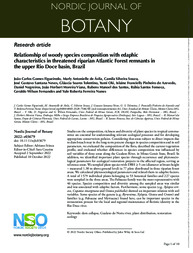Relationship of woody species composition with edaphic characteristics in threatened riparian Atlantic Forest remnants in the upper Rio Doce basin, Brazil.
Relationship of woody species composition with edaphic characteristics in threatened riparian Atlantic Forest remnants in the upper Rio Doce basin, Brazil.
Autoria: FIGUEIREDO, J. C. G.; ÁVILA, M. A. de; SOUZA, C. S.; NEVES, J. G. S.; TOLENTINO, G. S.; OKI, Y.; AZEVEDO, I. F. P. de; NEGREIROS, D.; VIANA, J. H. M.; SANTOS, R. M. dos; FONSECA, R. S.; FERNANDES, G. W.; NUNES, Y. R. F.
Resumo: Studies on the composition, richness and diversity of plant species in tropical communities are essential for understanding relevant ecological processes and for developing appropriate conservation policies. Considering that areas subject to direct impacts due to dam breach may in the long-term present changes in species composition and in soil parameters, we evaluated the composition of the flora, described the current vegetation profile, and evaluated whether differences in species composition was influenced by soil variables of three areas along the Gualaxo River, in Minas Gerais State, Brazil. In addition, we identified important plant species through occurrence and phytosociological parameters for ecological restoration projects in the affected region, serving as reference areas. We sampled plant species with DBH ≥ 5 cm (diameter at breast height ? measured 1.30 m above ground level) in 77 plots distributed in three riparian forest areas. We calculated phytosociological parameters and related them to edaphic factors. A total of 1579 individual plants belonging to 53 botanical families and 227 species were sampled in the three areas. The Fabaceae family was the most representative with 46 species. Species composition and diversity among the sampled areas was similar and was associated with edaphic factors. Furthermore, some species (e.g. Xylopia sericea, Cupania emarginata and Ocotea pulchalla) showed an important relation with soil variables. Some species of the genera (e.g. Byrsonima, Xylopia, Ocotea and Croton) and families (e.g. Fabaceae and Myrtaceae) found here, can be important species in the restauration process for the local and regional maintenance of floristic identity in the Rio Doce river.
Ano de publicação: 2022
Tipo de publicação: Artigo de periódico
Unidade: Embrapa Milho e Sorgo
Palavras-chave: Bacia Hidrográfica, Barragem, Ecologia, Mata Atlântica, Planta Lenhosa, Rio Doce, Rompimento de barragem
Observações
1 - Por padrão são exibidas publicações dos últimos 20 anos. Para encontrar publicações mais antigas, configure o filtro ano de publicação, colocando o ano a partir do qual você deseja encontrar publicações. O filtro está na coluna da esquerda na busca acima.
2 - Para ler algumas publicações da Embrapa (apenas as que estão em formato ePub), é necessário ter, no celular ou computador, um desses softwares gratuitos. Sistemas Android: Google Play Livros; IOS: iBooks; Windows e Linux: software Calibre.
Acesse outras publicações
Acesse a Base de Dados da Pesquisa Agropecuária (BDPA) para consultar o acervo completo das bibliotecas da Embrapa.

